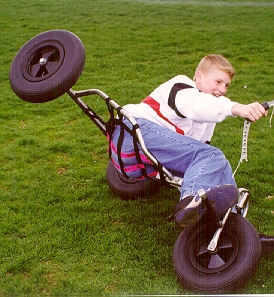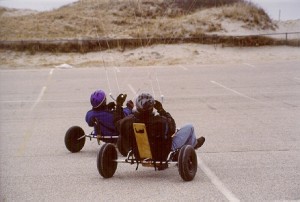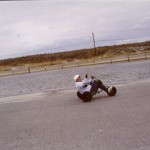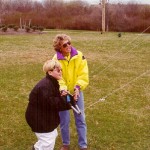Buggies – A Novice’s Odyssey
Things I learned in my rookie year as a buggy pilot. Many of you out there are probably a lot like me; you love flying kites but have never had the chance to try buggying. You skip over every thread on the subject of buggying and traction kites in the REC.KITES newsgroup. You very likely think that most of the buggiers that you’ve met are pretty strange, although this is often just simple jealousy. You’ve looked in the catalogs and seen how much a good traction kite costs, often several times the price of a good stunt kite. The price of the buggy also gives you pause and you may have even thought about how to build one from materials available at the Home Depot. I know exactly how you feel. I watched as Peter Lynn gave a tandem ride to Christie Whitman, the governor of New Jersey, on the beach at Wildwood. I’ve watched Jeff Howard just tear up those same beaches, usually on two wheels. I’ve drooled over their equipment and yes, I admit, I’ve even dreamed of flying in the Valhalla of buggying – the dry lakebeds of the southern California desert.
 All of this idle speculation died for me last October at the AKA convention. Early in the week we spotted someone walking around selling chances on a buggy and kite. No big announcements were made, just the low key, personal approach. I purchased one ticket for ten dollars. I forgot about the raffle during the week. There is so much to do at the convention and all of it fun! On Friday night they held a silent auction and then a loud (?) auction. I bid on several items in the silent auction. Everything I was interested in went for way over my budget. Next the loud auction was held, same story. I remember a nifty little Prism 3D (exotic materials and monofilm skin) fetching almost three hundred dollars. I was quite discouraged and was standing up, ready to leave. I saw the man who sold the raffle tickets up on the stage shaking the tickets up in a large jar and I decided to wait for a minute. The next thing I knew, he was calling out my name as the winner. My son had joined me at the convention earlier in the day and you could have knocked both of us over with a feather. The take – a Peter Lynn folding buggy, a Quadrifoil Q2004 (4 meter) foil, and a Laser Pro line set. I found out that Peter Lynn and Fran Gramkowski donated the buggy and Brian Smith of Quadrafoil donated the kite and lines. Also thrown in was a lesson from Jeff Howard! What a blessing and what a great way to get someone involved in buggying.
All of this idle speculation died for me last October at the AKA convention. Early in the week we spotted someone walking around selling chances on a buggy and kite. No big announcements were made, just the low key, personal approach. I purchased one ticket for ten dollars. I forgot about the raffle during the week. There is so much to do at the convention and all of it fun! On Friday night they held a silent auction and then a loud (?) auction. I bid on several items in the silent auction. Everything I was interested in went for way over my budget. Next the loud auction was held, same story. I remember a nifty little Prism 3D (exotic materials and monofilm skin) fetching almost three hundred dollars. I was quite discouraged and was standing up, ready to leave. I saw the man who sold the raffle tickets up on the stage shaking the tickets up in a large jar and I decided to wait for a minute. The next thing I knew, he was calling out my name as the winner. My son had joined me at the convention earlier in the day and you could have knocked both of us over with a feather. The take – a Peter Lynn folding buggy, a Quadrifoil Q2004 (4 meter) foil, and a Laser Pro line set. I found out that Peter Lynn and Fran Gramkowski donated the buggy and Brian Smith of Quadrafoil donated the kite and lines. Also thrown in was a lesson from Jeff Howard! What a blessing and what a great way to get someone involved in buggying.
Wildwood, New Jersey is cold and windy in October. The next day we took our booty out on the beach for our first buggy lesson. The wind was fifteen to twenty miles per hour. Jeff Howard helped me get the kite set up and launched. All of these professional buggy pilots thought that the conditions were just ideal and they expected me to just jump right on the buggy and go. I remember Jeff saying, ‘You fly quads right?’ When I told him that I can fly Revs he hands me the kite saying, ‘Same thing!’ Well, Revs can be exciting, but in my experience I’ve never feared for my life while flying them. The Quadrifoil has an amazing amount of pull. I am almost six feet seven inches tall and two hundred and seventy five pounds and that kite in those wind conditions completely over powered me. It was so fast and powerful that I was actually glad when one of the bridle lines snapped. WOW! What have I gotten myself into? This is scary stuff. I was disappointed to have to leave those great beaches without actually even getting a buggy ride, but I knew I would be back. On the plus side we had learned several important lessons.
Lesson One –
You must match the size of the kite to your skill level and the wind conditions.
Lesson Two –
You need to learn to fly and control your kite before you try to get in the buggy.
On the negative side we figured out why the experienced buggy pilots have so many different kites. One size is never enough if you want to have fun in different conditions. I love sport kites and I collect them not out of need so much as desire. This is something different, when you are afraid for your life, a smaller sized kite can make all the difference. We left Wildwood with dreams of returning in the spring. I think it rained for the next six consecutive weekends, but the winter was very mild and we did eventually get to fly again. We took the Q2004 out in the park and learned what made it tick. We even tried the buggy out a few times, but it never seemed that we had enough wind. This is very frustrating, but our practice sessions did lead to a few more lessons.
Lesson Three –
A good, consistent wind of around ten to twelve miles per hour is the minimum required.
Lesson Four –
It’s completely different flying a kite from the seated position (more practice needed).
 As winter turned into spring we did have a few notable successes on the buggy in the park. We flew in around twelve miles per hour and were able to roll perpendicular to the wind. We made our first powered turns and were even able to head slightly upwind. I keep telling you what ‘we’ have been up to. I’m talking about my son Peter (12 years old) and our local kiter friend Glenn. As a Christmas present I bought a new Quadrifoil Q2003 (3 meter) kite. This smaller kite was purchased with my son in mind. Glenn has a friend who is a welder/fabricator. Guess what Glenn got for Christmas? (hint – it involves stainless steel tubing) We were very excited to read in the REC.KITES newsgroup about an AKA Region One fly that was scheduled for early April in Newport, Rhode Island. They were going to conduct a buggy clinic – just what we needed! We packed the car and headed up to Newport. The clinic was sponsored by the HIGH FLYERS FLIGHT COMPANY. The teachers were Ray and Jeanne Merry from Cobra Kites. Ray is the co-designer of the Flexifoil kite and we felt honored to learn from them. This is a great way to try out different kites and buggies. I highly recommend this type of clinic. Seek them out, check the Cobra Kites web site for a list of places they will be touring this year. After 90 minutes of lectures we went out on the hotel lawn to fly some kites. Cobra Kites are the distributors for Sky Tigers. They brought with them a bewildering array of different sized and shaped kites and several buggies for people to try.
As winter turned into spring we did have a few notable successes on the buggy in the park. We flew in around twelve miles per hour and were able to roll perpendicular to the wind. We made our first powered turns and were even able to head slightly upwind. I keep telling you what ‘we’ have been up to. I’m talking about my son Peter (12 years old) and our local kiter friend Glenn. As a Christmas present I bought a new Quadrifoil Q2003 (3 meter) kite. This smaller kite was purchased with my son in mind. Glenn has a friend who is a welder/fabricator. Guess what Glenn got for Christmas? (hint – it involves stainless steel tubing) We were very excited to read in the REC.KITES newsgroup about an AKA Region One fly that was scheduled for early April in Newport, Rhode Island. They were going to conduct a buggy clinic – just what we needed! We packed the car and headed up to Newport. The clinic was sponsored by the HIGH FLYERS FLIGHT COMPANY. The teachers were Ray and Jeanne Merry from Cobra Kites. Ray is the co-designer of the Flexifoil kite and we felt honored to learn from them. This is a great way to try out different kites and buggies. I highly recommend this type of clinic. Seek them out, check the Cobra Kites web site for a list of places they will be touring this year. After 90 minutes of lectures we went out on the hotel lawn to fly some kites. Cobra Kites are the distributors for Sky Tigers. They brought with them a bewildering array of different sized and shaped kites and several buggies for people to try.
After lunch and a quick stop at the Sky High Kite Shop, we headed to the beach. The ‘good beach’ was full of kite flyers so we headed to beach number two. Bad news – high tide, rocks and soft sand. The Newport beaches are lovely and they have excellent facilities including long empty parking lots. We got the buggies and kites out and started to roll! The wind was close to fifteen miles per hour and maybe thirty degrees off perpendicular to the lot. Did I mention it was cold? I started out with the four meter Q2000 and was doing pretty good. Soon more buggies showed up and joined us. There were at least a dozen or so at one point. Many of the late comers were more experienced buggiers and they were all downsizing their kites. I wanted Peter to have a go so we put the three meter kite up. At this point I need to interject a new lesson.
Lesson Five –
Always wear a good helmet as well as elbow and knee pads and gloves.
I really feel that I had seriously taken lesson number one to heart, but as I said before, I don’t weigh anywhere near the one hundred twenty pounds that my son does. Peter tried valiantly several times to get moving. Each time he would over fly the edge causing the kite to collapse and drift back into the power zone. Once in the power zone, the kite reinflates and BANG, it’s instantly travelling very fast and pulling you in a direction that you don’t want to go – sideways. He flipped out of the buggy three times. The third he came up bloody and as I ran up to him, he was spitting something out. I immediately thought – teeth! He said no, his teeth were OK. He was spitting out stones – very macho! We decided that the asphalt had taken enough damage for one day and Peter hung up his helmet. Peter was OK – a few small scrapes and bruises. Note to self – call Jeff Howard about buying a smaller kite. I continued to have fun. The lot was very long and one of the nerdier buggy pilots had a GPS on his buggy. He clocked around five miles and a maximum speed of fifteen miles per hour. I don’t know how fast I went, but it felt like fifty or sixty. On one very fast run the wind started singing with my lines. I’m not sure, but it sounded like they were singing – AOXOMOXOA. This stuff is fun! Several new lessons were learned.
Lesson Six –
Start small… the smallest kite that will allow you to roll is the best starting point.
A small kite will allow you to learn the ropes at a slower pace. The small kite may require more work to generate pull, but this is a very useful skill that can be applied to a larger kite. A friend of mine later told me that she never has any trouble getting a smaller kite when needed. All the guys are using their bigger kites and don’t mind sharing the smaller ones. Don’t be afraid to seek out a smaller kite.
Lesson Seven –
Once you learn to get rolling, learn to slow down and stop before you are forced to.
There is a lot of stuff happening at once. Learning how to slow down and stop can save you from a nasty spill. The drill is fairly easy. First, depower the kite by flying it overhead. Second, slow the buggy (and yourself) down by heading slightly upwind. Fancy skids and such are for the advance class. Never try to stop à la Fred Flinstone while the kite is still generating pull. Learn this important skill before you get into trouble.
Lesson Eight –
Practice ditching the kite… learn to let go.
It’s not natural to let go; ask Peter. You are holding on for dear life, normally. Practice this a few times in the park. It won’t hurt the kite and you don’t have to run very far to recover it. When Peter was yanked out of the buggy I asked him why he didn’t let go. He said, “I did when my elbows hit the ground.” (see lesson #5)
We came home from Newport and took the buggies out to the park the next day. Peter did much better at recognizing when the kite was in trouble and controlling it. We are still working on lesson seven, but he did ditch it once and we had no more spills! I hope you have enjoyed this novice odyssey into the world of buggying. I’ll try to keep you up to date with our further adventures. Next stop – Wildwood for the ECSKC and the Wild Wheels Buggy Blast!
Peter C Hugger




